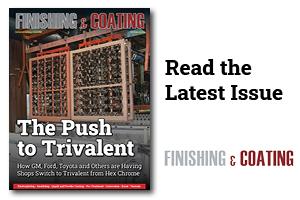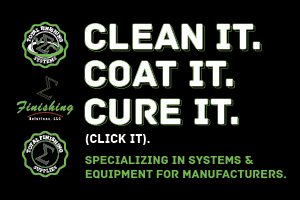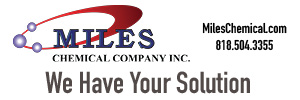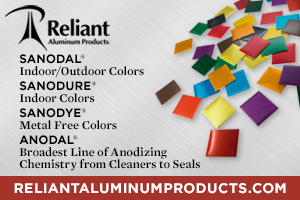Every quarter in the business cycle presents new challenges, anticipated goals, and other projects, all of which aim to help us progress and make the current operation successful.
 Stephen Rudy CEFWe acknowledge making plans, reviewing processes, targeting new areas or modifications to existing ones, and anticipating ISO NADCAP audits, among other tasks. The checklist is a popular way of organizing our thoughts and plans, which are typically geared towards improvements to meet planned objectives. Many projects are outlined with anticipated completion dates, tied into budgetary allocations, and customer requirements. Others are a result of an urgent response to correcting a problem. Some may be due to necessary action to seize an opportunity for new or enhanced business.
Stephen Rudy CEFWe acknowledge making plans, reviewing processes, targeting new areas or modifications to existing ones, and anticipating ISO NADCAP audits, among other tasks. The checklist is a popular way of organizing our thoughts and plans, which are typically geared towards improvements to meet planned objectives. Many projects are outlined with anticipated completion dates, tied into budgetary allocations, and customer requirements. Others are a result of an urgent response to correcting a problem. Some may be due to necessary action to seize an opportunity for new or enhanced business.
Try to get a consensus, as a group, to create and maintain a checklist. In general terms, a checklist may encompass a wide range of subjects. Here are some items that may be important. Keep in mind that almost all examples contribute to insurance premiums. As described in recent www.FinishingAndCoating.com articles, insurance coverage and associated premiums have become very critical and expensive to metal finishers.
The Physical Plant: Exterior
A survey should determine if security, roofing, siding, lighting, signage, paved surfaces, and loading docks are adequate. The plant should be a welcome example of the immediate neighborhood. Where applicable, a clean and landscaped property conveys the prestige of the company and impresses customers and other visitors.
Company Vehicles
Aside from the strict requirements (inspection, registration, insurance, transport stickers, placards, etc.), maintain a routine maintenance schedule. Keep vehicles clean and orderly. Advertise the company with appropriately stenciled information. Check mileage to anticipate lease agreements or plan a new purchase.
Plant Interior
The vestibule or waiting area should be clean and sufficient to accommodate guests and visitors. Sign in ledger and safety glasses are required. The office should be organized regarding bookkeeping, billing, inventory, the conference room, and other necessary spaces. Good lighting is very important. Walkways leading to and into the plant should be marked.
Computers
Determine if the hard drives and programs are sufficient not only now, but going forward. Install upgrades as deemed necessary. Back up data regularly. Viruses and breakdowns occur. Hacking is always a concern. Don’t risk losing information that is very important to the business. Invest in an IT specialist, in-house or contract.
Communication
Companies overwhelmingly use cell phones for inter-company communication. Research available plans that offer the best features at an economical price.
Websites are popular advertising media for companies. It is truly eye-opening to see how many “hits” occur through interested companies. Investing in design and upgrades can yield interesting new sales opportunities.
The Physical Plant: Interior
The insurance company may be a most helpful source to audit and identify areas for improvement (this would certainly include the exterior). As regards process lines, equipment, and work areas, there are numerous items to consider. Tanks and liners require inspection and, if necessary, replacement. Be aware that bowed or bent tank walls may be a result of using the wrong material for the construction or operating conditions. Tanks should, according to local and state regulations, accurately describe health hazards and other relevant information, such as CAS numbers. Rinsing may need improvement by installing additional rinses or sprays. Verify that plating tanks have a sufficient surface area of anodes. For electropolishing and anodizing, it is the total area of the cathodes. Filters may need service or replacement parts. Perhaps filters need to be installed in the first place. Rectifiers do require routine service. Defects, such as excess ripple, must be corrected. Rack tips continually build up with plated deposits that require stripping. Racks may break, linings split, and drawing in solutions that contaminate other process baths. The usual problems of wear and tear affect plating barrels, including warping, loose doors, over-plated danglers, and plugged barrel perforations. Mass finishing equipment does require routine service. Moving parts need lubrication, liners tend to wear and crack, and vibratory bowls need periodic checks for proper balance. Belts wear out.
Inventoried and stored chemicals should be in their proper place, labeled as required. Homeland Security has issued specific regulations for the storage of particular chemical types. Accurately maintained ledgers listing daily chemical inventories are very important. This refers to government requirements for certain chemical groups. In the process applications, it is essential to be organized, thereby avoiding critical shortfalls that could impede or halt production.
Products / Processes
Vendors continually upgrade and introduce new products and processes. This is in response to improvements such as economics, production throughput, inventory requirements, easing demands on waste treatment, and meeting or exceeding more stringent wear resistance specifications. It is essential to identify what is available that can not only simplify the workload but also offer improved performance. Plan accordingly. Be proactive.
The Lab
An inventory of chemicals and reagents should confirm stock requirements and identify any items that have passed their date of use. This is especially critical when adhering to ISO and NADCAP requirements. Equipment such as hoods, thickness testers, pH meters, and other related equipment for analysis and quality control may need calibration. Data and records should be up to date and saved in case of computer malfunction. Analysis methods may be updated to comply with any new requirements. Analysis schedules should be reviewed and adjusted as needed. Suppliers should be helpful about proprietary processes. The lab staff may require updated training on safety and analysis methods. NASF is a good source for educational materials.
Waste Treatment
Our industry is very dependent on functional waste treatment systems. Citations, fines, and possible shutdowns may result if discharge compliance is not met. We are dealing not only in low parts per million measurements, but in some applications, parts per billion become critical as well. Therefore, a checklist should be very important, monitored for progress, and updated or amended as conditions require. Waste treatment process lines should be evaluated for modifications and improvements. Equipment such as tanks, filters, and pumps needs regular inspection for serviceable performance. pH and ORP meters should be calibrated daily. Chemicals used in the process should be properly dispensed at the optimum dosages. Don’t shock the system with rapid, bulk solution dumps. Suppliers of waste treatment processes and chemistries should offer expert recommendations and on-site services. It is a big relief for customers to know that their metal finishing vendor shops are compliant and, in many instances, officially certified for compliance.
Get ready for action. An effective checklist can be very helpful. Consult with your staff and regional suppliers to gather their input. Most importantly, be organized and stay the course.
Stephen F. Rudy, CEF, is president of Chem Analytic and has written extensively about the finishing industry. Visit www.chemanalytic.com or call him at 917-604-5001.



































